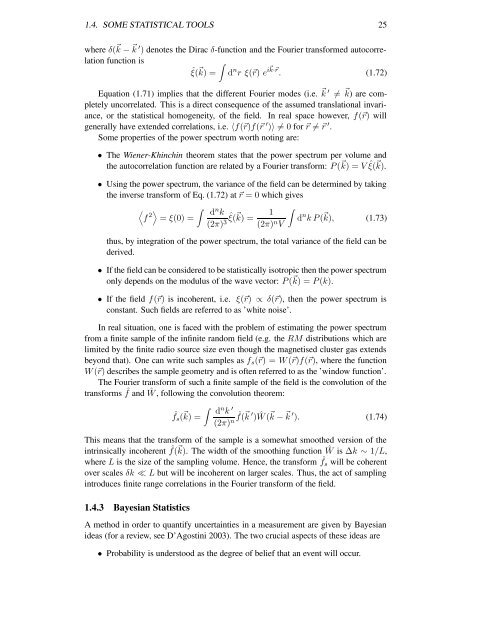Investigations of Faraday Rotation Maps of Extended Radio Sources ...
Investigations of Faraday Rotation Maps of Extended Radio Sources ...
Investigations of Faraday Rotation Maps of Extended Radio Sources ...
You also want an ePaper? Increase the reach of your titles
YUMPU automatically turns print PDFs into web optimized ePapers that Google loves.
1.4. SOME STATISTICAL TOOLS 25<br />
where δ( ⃗ k − ⃗ k ′ ) denotes the Dirac δ-function and the Fourier transformed autocorrelation<br />
function is<br />
∫<br />
ˆξ( ⃗ k) = d n r ξ(⃗r) e i⃗k·⃗r . (1.72)<br />
Equation (1.71) implies that the different Fourier modes (i.e. ⃗ k ′ ≠ ⃗ k) are completely<br />
uncorrelated. This is a direct consequence <strong>of</strong> the assumed translational invariance,<br />
or the statistical homogeneity, <strong>of</strong> the field. In real space however, f(⃗r) will<br />
generally have extended correlations, i.e. 〈f(⃗r)f(⃗r ′ )〉 ≠ 0 for ⃗r ≠ ⃗r ′ .<br />
Some properties <strong>of</strong> the power spectrum worth noting are:<br />
• The Wiener-Khinchin theorem states that the power spectrum per volume and<br />
the autocorrelation function are related by a Fourier transform: P ( ⃗ k) = V ˆξ( ⃗ k).<br />
• Using the power spectrum, the variance <strong>of</strong> the field can be determined by taking<br />
the inverse transform <strong>of</strong> Eq. (1.72) at ⃗r = 0 which gives<br />
〈<br />
f 2〉 ∫<br />
= ξ(0) =<br />
d n k<br />
(2π) 3 ˆξ( ⃗ k) =<br />
1<br />
(2π) n V<br />
∫<br />
d n k P ( ⃗ k), (1.73)<br />
thus, by integration <strong>of</strong> the power spectrum, the total variance <strong>of</strong> the field can be<br />
derived.<br />
• If the field can be considered to be statistically isotropic then the power spectrum<br />
only depends on the modulus <strong>of</strong> the wave vector: P ( ⃗ k) = P (k).<br />
• If the field f(⃗r) is incoherent, i.e. ξ(⃗r) ∝ δ(⃗r), then the power spectrum is<br />
constant. Such fields are referred to as ’white noise’.<br />
In real situation, one is faced with the problem <strong>of</strong> estimating the power spectrum<br />
from a finite sample <strong>of</strong> the infinite random field (e.g. the RM distributions which are<br />
limited by the finite radio source size even though the magnetised cluster gas extends<br />
beyond that). One can write such samples as f s (⃗r) = W (⃗r)f(⃗r), where the function<br />
W (⃗r) describes the sample geometry and is <strong>of</strong>ten referred to as the ’window function’.<br />
The Fourier transform <strong>of</strong> such a finite sample <strong>of</strong> the field is the convolution <strong>of</strong> the<br />
transforms ˆf and Ŵ , following the convolution theorem:<br />
∫<br />
ˆf s ( ⃗ d n k ′<br />
k) =<br />
(2π) ˆf( ⃗ n k ′ )Ŵ (⃗ k − ⃗ k ′ ). (1.74)<br />
This means that the transform <strong>of</strong> the sample is a somewhat smoothed version <strong>of</strong> the<br />
intrinsically incoherent ˆf( ⃗ k). The width <strong>of</strong> the smoothing function Ŵ is ∆k ∼ 1/L,<br />
where L is the size <strong>of</strong> the sampling volume. Hence, the transform ˆf s will be coherent<br />
over scales δk ≪ L but will be incoherent on larger scales. Thus, the act <strong>of</strong> sampling<br />
introduces finite range correlations in the Fourier transform <strong>of</strong> the field.<br />
1.4.3 Bayesian Statistics<br />
A method in order to quantify uncertainties in a measurement are given by Bayesian<br />
ideas (for a review, see D’Agostini 2003). The two crucial aspects <strong>of</strong> these ideas are<br />
• Probability is understood as the degree <strong>of</strong> belief that an event will occur.
















